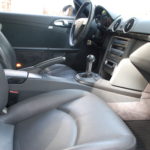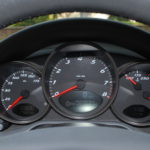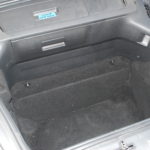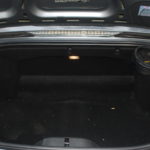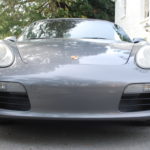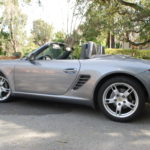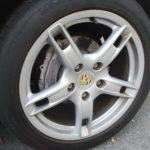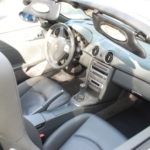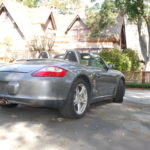912, 914, 924, and 944. What do all of these have in common? They represent different generations of entry level Porsches. For many years, the entry level Porsche was always a compromise because most of them didn’t deliver anything near 911 levels of performance (save for the 914-6 and 944 Turbo, but those are sore subjects for the purists). When Porsche decided to release the original 986 Boxster, it was the first time the baby Porsche was given the famed flat six engine in an affordable package.
Unlike its big brother the 911, the Boxster doesn’t scare the driver with the thought of the pendulum engine kicking the rear end out if you let off the throttle mid corner.
Recently I was given the chance to drive a 987 Boxster, which is the second generation car. I had never driven a Boxster before, so of course I was curious to see if the bargain P-car was everything the motoring press has praised it to be. In this case, the car in question is a 2005 Boxster, so as basic of a Boxster as one could buy (aside from the optional 18” wheels).
Eyeballin’
On the outside, the styling of the 987 design is definitely a welcome revision from the more bulbous proportions of the first gen cars. As the Boxster and its Cayman sibling have matured, they have also gotten progressively better looking. Perhaps the profile isn’t as iconic as the famed 911, but park your Boxster along the boulevard for Saturday night dinner, and it won’t look a shade out of place.
- A simple interior, but who cares when you have a flat six cylinder right behind your ears.
- You can see where the priorities lie.
- The front trunk, or “frunk,” has plenty of storage space.
- The rear trunk has adequate capacity, it’s also where you check the Boxster’s fluid levels.
Inside the Boxster is stereotypically German. There are leather appointments and everything has a tight fit and finish, but it’s a workplace aimed at the minimalist. That approach is also why the Boxster is priced the way it is. There are clues that the VW parts bin was rummaged through in an effort to put the interior together. Owners of MK4 Golf GTIs will notice the Boxster’s shift knob and door chime seem strangely familiar. Not a deal breaker, but just a comical observation. What was most surprising is the amount of storage space in the “frunk.” A set of golf clubs isn’t going to fit very well, but you could probably fold the short guy from Ocean’s 11 in there with room to spare.
Not Just a Sporty Beetle
Let’s cut to the chase. The real reason anyone buys a Boxster is because of the way it drives. Start the car with your left hand and enjoy the symphony of the 2.7 flat six roaring to life. Slip the 5-speed transmission into gear and off you go. Pedal placement is slightly offset to the right, but the pedals themselves are light and easy to use, meaning stop and go traffic won’t be too tiresome on your left foot.
As with any sports car, you want the engine up to operating temperature before winding it out. But once all systems check out, there’s no resisting the urge to sweep the tach towards 7,000 RPM and listen to the glorious exhaust note. The 240 horsepower won’t snap necks, but it’s more than enough to carve up any road you throw at the sub 3,000 lb. Boxster. It’s under these circumstances where the car comes into its own. The suspension feels planted, and the steering responds with just the right amount of feedback. The ride is firm without being overly harsh. For a factory suspension, it’s very capable. Then again, Porsche has been making sports cars since the late 1940s, so of course it’s going to be good!
- The 987 has a clean front end with slightly more aggressive styling than its predecessor.
- The rear end is where the Boxster separates itself on the family tree. No mistaking it for a 911.
- With the top down you can see the inspiration for the Boxster stems back to 550 Speedster, made famous by the likes of James Dean.
Fanboys will still say, “911 or Die,” but I’m starting to understand the appeal of the mid-ship fighter. Unlike its big brother the 911, the Boxster doesn’t scare the driver with the thought of the pendulum engine kicking the rear end out if you let off the throttle mid corner. It’s simply a better balanced car. I’m also certain that a lot of time was spent tuning the brakes because they’re top notch. The four piston calipers and drilled rotors are instantaneous to respond with superb pedal feel. Even the most abusive of drivers will have a field day before experiencing any fade.
Justifundible
Normally I’d stray away from a car that doesn’t house its engine up front and center, but the starter P-Car is surprisingly friendly to the DIY enthusiast. Changing out the belt or spark plugs is not going to be done in a traditional manner, but not nearly as horrible as I would have expected (thanks in part to the longitudinal engine placement). The Achilles Heel of Porsche cars from this era though is the infamous IMS bearing, which can cause catastrophic damage if not replaced with the updated design. It’s a spendy repair, but you can often find cars with this issue already addressed.
- 18″ wheels were an option over the standard 17″ rollers.
Am I going to drop everything and sell the BMWs? Probably not, but the differences between a sporty car and a dedicated sports car have definitely got the gears turning. More importantly is the term “Affordable Porsche” doesn’t have to be an oxymoron. The Boxster represents a fork in the road for the Porsche model lineup. By that I mean the 911 is no longer required to be a bare bones sports car, but rather the GT luxury automobile it’s ultimately matured into. Yes, you can get a 911 in both guises, but we all know the hardcore drivers gravitate towards the smaller, lighter Boxster (and Cayman).
Performance numbers of the Boxster will never stomp the 911 due to corporate politics (think Camaro vs. Corvette), but they can get pretty close. Some argue the Boxster may have been one of Porsche’s worst marketing decisions because it stole so many sales from the 911. Seeing as well over 100,000 cars were built in the first generation alone, I think it’s safe to say it was one of their best.
-JC
SPECS
- Year: 2005
- Color: Seal Grey
- Drivetrain: Mid Engine Rear Wheel Drive
- Engine: 2.7 liter flat six cylinder DOHC (water cooled)
- Power: 240 hp
- Torque: 199 lb/ft
- Weight: 2900 lbs.


